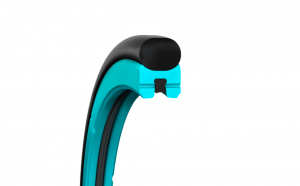
This double-acting rotary seal delivers twice the pressure velocity and a 50% reduction in friction. In testing, wear of the seal and O-Ring was so low that its measurement was inconsequential.
Leaking rotary seals can create a headache for anyone within the fluid power industry. There is a fine line between ensuring a rotary seal has enough lubrication to prolong a seal’s life and having so much it causes leakage. Without sufficient lubrication, the seal life is shortened due to excessive wear and heat. System costs also increase due to additional frictional torque.
To remedy potential issues with leakage, fluid power design engineers can take a few precautions, such as the use of redundant seals or a drain line. Manufacturers can lower hardware cost and increase functionality with new sealing innovations designed to decrease torque and increase seal life.
For instance, using a seal with an integrated check valve function and high contact force on the seal edge helps to increase lubrication while decreasing leakage. In redundant sealing systems, the check valve function automatically releases inter-stage pressure build up when system pressure drops.
Seal designs with valve ports made from both sides of the O-Ring profile to the space in the center provide a lubricating groove. Like other O-Ring-activated slipper seals, the initial squeeze of the O-Ring ensures enough contact pressure between seal and mating surface to provide sealing at low pressure. As the system pressure increases, the O-Ring and the seal body have direct contact force on the sealing surface to ensure sealing efficiency at all pressures. A double-acting four-lip seal installed in the lubricating groove prevents static leakage through the ports. When this lip seal is pressurized from one side, it opens the port on the pressure side, equalizing the pressure beneath the elastomer ring.
Seal diameters can range from about 1-in. to 2-ft-2 in. (22 mm to 660 mm) and operating temperatures can be from -22 to +392 °F (-30 to +200 °C), making them well suited to fluid power applications.
A solution like this provides multiple seal points on the ring, requiring less compression to provide an effective seal. By creating less force to seal, there is less friction and wear, reducing potential downtime. When pressurized, the elastomer ring opens the port on the pressure side and equalizes the pressure beneath the double-acting four-lip ring — pressure balancing the seal by more than half.
Shifting pressurization through the ports renews the fluid in the space between the “legs,” improving lubrication under the seal. This level of lubrication is optimal because the grooves on the inner and outer diameter of the ring maintain lubrication, lowering friction and extending the life of the seal.
The sealing industry has answered a need for rotary seals that run at higher speeds at higher pressure and extended seal life for more demanding applications where a high pressure to velocity value is required. This double-acting rotary seal delivers twice the pressure velocity and a 50% reduction in friction. In testing, wear of the seal and O-Ring was so low that its measurement was inconsequential.
Specialized rotary seals can be well suited to address high-speed, high-pressure applications that need continuous service at high and low-pressure velocity (PV) values. The seals give improved performance in oscillating conditions and applications involving frequent pressure and velocity changes. These double-acting rotary seals are tested with low frictional torque at all pressures from 0.5 MPa / 72.5 psi and above with low sensitivity to pressure increases from 0.5 to 20 MPa / 72.5 to 2900 psi. They are suitable for equipment for which a long service life is required in demanding service conditions.
Hydraulic swivels, lead-troughs, rotary connections with swivel movements, excavators, hydraulic rotators, robots, manipulators, indexing tables, pivoting motors, hydraulic motors, blow molding machines, top drives and core cutting equipment and other applications would benefit from rotary seals that can run at higher speeds combined with higher pressures. They not only achieve these requirements but generate lower heat, which reduces the wear on the seal. For the equipment operator, that means lower overall costs from reduced maintenance requirements and energy consumption. DW
Trelleborg
trelleborg.com
Filed Under: Sealing, Sealing & Contamination Control Tips